Characterisation of Tribological Properties and Morphologies of Ni-P and Ni-B Coatings
Abstract
1. Introduction
2. Experiments
2.1. Preparation of Test Specimens
2.2. Coating Methods
2.3. The Coating Thickness
2.4. The Surface Morphologies
2.5. Wear Volume Calculated
3. Results and Discussion
3.1. Chemical Composition
3.2. Microhardness
3.3. Coefficient of Friction (COF)
3.4. Wear Analysis
3.5. Wear Coefficients
4. Conclusions
Author Contributions
Funding
Data Availability Statement
Acknowledgments
Conflicts of Interest
References
- Li, J.; Yan, H.; Li, S.; Lei, M. Microstructure and wear behavior of arc-shaped 40CrNiMo steel after laser hardening. J. Mater. Res. Technol. 2023, 24, 5743–5754. [Google Scholar] [CrossRef]
- Lee, M.K.; Kim, G.H.; Kim, K.H.; Kim, W.W. Effects of the surface temperature and cooling rate on the residual stresses in a flame hardening of 12Cr steel. J. Mater. Process. Technol. 2006, 176, 140–145. [Google Scholar] [CrossRef]
- Chen, W.; He, X.; Yu, W.; Wang, M.; Yao, K. Microstructure, Hardness, and Tensile Properties of Vacuum Carburizing Gear Steel. Metals 2021, 11, 300. [Google Scholar] [CrossRef]
- Casteletti, L.C.; Neto, A.L.; Totten, G.E. Nitriding of Stainless Steels. Metallogr. Microstruct. Anal. 2014, 3, 477–508. [Google Scholar] [CrossRef]
- Fotovvati, B.; Namdari, N.; Dehghanghadikolaei, A. On Coating Techniques for Surface Protection: A Review. JMMP 2019, 3, 28. [Google Scholar] [CrossRef]
- Czagány, M.; Varanasi, D.; Sycheva, A.; Janovszky, D.; Koncz-Horváth, D.; Kristaly, F.; Baumli, P.; Kaptay, G. Synthesis, characterisation and thermal behaviour of Cu-based nano-multilayer. J. Mater. Sci. 2021, 56, 7823–7839. [Google Scholar] [CrossRef]
- He, Q.; Paiva, J.M.; Kohlscheen, J.; Beake, B.D.; Veldhuis, S.C. An integrative approach to coating/carbide substrate design of CVD and PVD coated cutting tools during the machining of austenitic stainless steel. Ceram. Int. 2020, 46, 5149–5158. [Google Scholar] [CrossRef]
- Xie, Y.; Liu, J.; Liu, W.; Li, Q.; Feng, W.; Yang, L.; Zhou, Y. Performance and failure modes of thermal barrier coatings deposited by EB-PVD on blades under real service conditions in gas turbine. J. Alloys Compd. 2024, 1008, 176889. [Google Scholar] [CrossRef]
- Siwawut, S.; Srikhumsuk, P.; Butdee, S. Tool life and wear prediction of HSS and PVD material using ANFIS system. Mater. Today Proc. 2023, S2214785323048538. [Google Scholar] [CrossRef]
- Vasu, C.; Andhare, A.B.; Dumpala, R. Machinability and tool wear studies on AZ91/B4C metal matrix composites using uncoated and CVD diamond coated WC-Co turning inserts. Int. J. Refract. Met. Hard Mater. 2024, 119, 106538. [Google Scholar] [CrossRef]
- Larson, C.; Smith, J.R. Recent trends in metal alloy electrolytic and electroless plating research: A review. Trans. IMF 2011, 89, 333–341. [Google Scholar] [CrossRef]
- Agarwala, R.C.; Agarwala, V.; Sharma, R. Electroless Ni-P Based Nanocoating Technology—A Review. Synth. React. Inorg. Met.-Org. Nano-Met. Chem. 2006, 36, 493–515. [Google Scholar] [CrossRef]
- Shakoor, R.A.; Kahraman, R.; Gao, W.; Wang, Y. Synthesis, Characterization and Applications of Electroless Ni-B Coatings—A review. Int. J. Electrochem. Sci. 2016, 11, 2486–2512. [Google Scholar] [CrossRef]
- Barati, Q.; Hadavi, S.M.M. Electroless Ni-B and composite coatings: A critical review on formation mechanism, properties, applications and future trends. Surf. Interfaces 2020, 21, 100702. [Google Scholar] [CrossRef]
- Kumar, S.; Banerjee, T.; Patel, D. Tribological characteristics of electroless multilayer coating: A review. Mater. Today Proc. 2020, 33, 5678–5682. [Google Scholar] [CrossRef]
- Gyökér, Z.; Gergely, G.; Takáts, V.; Gácsi, Z. Machine learning-assisted characterization of electroless deposited Ni–P particles on nano/micro SiC particles. Ceram. Int. 2023, 49, 29849–29856. [Google Scholar] [CrossRef]
- Sudagar, J.; Lian, J.; Sha, W. Electroless nickel, alloy, composite and nano coatings—A critical review. J. Alloys Compd. 2013, 571, 183–204. [Google Scholar] [CrossRef]
- Czagany, M.; Baumli, P. Effect of pH on the characteristics of electroless Ni-P coatings. J. Min. Met. B Met. 2017, 53, 327–332. [Google Scholar] [CrossRef]
- Umapathi, D.; Devaraju, A.; Rathinasuriyan, C.; Raji, A. Mechanical and tribological properties of electroless nickel phosphorous and nickel Phosphorous-Titanium nitride coating. Mater. Today Proc. 2020, 22, 1038–1042. [Google Scholar] [CrossRef]
- Solimani, A.; Meißner, T.M.; Oskay, C.; Galetz, M.C. Electroless Ni–P coatings on low-Cr steels: A cost-efficient solution for solar thermal applications. Sol. Energy Mater. Sol. Cells 2021, 231, 111312. [Google Scholar] [CrossRef]
- Vitry, V.; Hastir, J.; Mégret, A.; Yazdani, S.; Yunacti, M.; Bonin, L. Recent advances in electroless nickel-boron coatings. Surf. Coat. Technol. 2022, 429, 127937. [Google Scholar] [CrossRef]
- Yazdani, S.; Vitry, V. RSM models approach for optimization of the mechanical properties of electroless Ni-B-nanodiamond coating: An experimental and molecular dynamic simulation study. Surf. Coat. Technol. 2023, 452, 129133. [Google Scholar] [CrossRef]
- Ahmed, S.Y.; Mahmoud, S.B.; Shoeib, M.A. Synthesis, structure characterization, and corrosion properties of duplex electroless Ni-P/Ni-B and Ni-P/Ni-BW coatings on mild steel. Sci. Rep. 2024, 14, 24983. [Google Scholar] [CrossRef]
- Loto, C.A. Electroless Nickel Plating—A Review. Silicon 2016, 8, 177–186. [Google Scholar] [CrossRef]
- Czagány, M.; Baumli, P. Effect of surfactants on the behavior of the Ni-P bath and on the formation of electroless Ni-P-TiC composite coatings. Surf. Coat. Technol. 2019, 361, 42–49. [Google Scholar] [CrossRef]
- Balaraju, J.N.; Narayanan, T.S.N.S.; Seshadri, S.K. Electroless Ni–P composite coatings. J. Appl. Electrochem. 2003, 33, 807–816. [Google Scholar] [CrossRef]
- Czagany, M.; Hompoth, S.; Windisch, M.; Baumli, P. Investigation of the Supercapacitive Behavior of Electroless Ni-B Coatings. Metals 2023, 13, 1233. [Google Scholar] [CrossRef]
- Erdemir, F.; Güler, O.; Çanakçı, A. Electroless nickel-phosphorus coated expanded graphite paper: Binder-free, ultra-thin, and low-cost electrodes for high-performance supercapacitors. J. Energy Storage 2021, 44, 103364. [Google Scholar] [CrossRef]
- Sharma, P.J.; Modi, K.H.; Sahatiya, P.; Sumesh, C.K.; Pataniya, P.M. Electroless deposited NiP-fabric electrodes for efficient water and urea electrolysis for hydrogen production at industrial scale. Appl. Surf. Sci. 2024, 644, 158766. [Google Scholar] [CrossRef]
- Delaunois, F.; Vitry, V.; Bonin, L. (Eds.) Electroless Nickel Plating: Fundamentals to Applications, 1st ed.; CRC Press: Boca Raton, FL, USA, 2019. [Google Scholar] [CrossRef]
- Czagány, M.; Baumli, P.; Kaptay, G. The influence of the phosphorous content and heat treatment on the nano-micro-structure, thickness and micro-hardness of electroless Ni-P coatings on steel. Appl. Surf. Sci. 2017, 423, 160–169. [Google Scholar] [CrossRef]
- Krishnan, K.H.; John, S.; Srinivasan, K.N.; Praveen, J.; Ganesan, M.; Kavimani, P.M. An overall aspect of electroless Ni-P depositions—A review article. Met. Mater. Trans. A 2006, 37, 1917–1926. [Google Scholar] [CrossRef]
- Wang, P.; Liang, H.; Jiang, L.; Qian, L. Effect of nanoscale surface roughness on sliding friction and wear in mixed lubrication. Wear 2023, 530, 204995. [Google Scholar] [CrossRef]
- Park, J.Y.; Salmeron, M. Fundamental aspects of energy dissipation in friction. Chem. Rev. 2014, 114, 677–711. Available online: https://pubs.acs.org/doi/10.1021/cr200431y (accessed on 7 February 2024).
- Khaday, S.; Li, K.W.; Peng, L.; Chen, C.C. Relationship between friction coefficient and surface roughness of stone and ceramic floors. Coatings 2021, 11, 1254. [Google Scholar] [CrossRef]
- DIN 51834-1; Testing of Lubricants—Tribological Test in the Translatory Oscillation Apparatus—Part 1: General Working Principles. Deutsches Institut Fur Normung: Berlin, Germany, 2010.
- Ravikiran, A. Wear Quantification. J. Tribol. 2000, 122, 650–656. [Google Scholar] [CrossRef]
- Liu, T.; Yu, J.; Wang, H.; Yu, Y.; Li, H.; Zhou, B. Modified method for determination of wear coefficient of reciprocating sliding wear and experimental comparative study. J. Mar. Sci. Eng. 2022, 10, 1014. [Google Scholar] [CrossRef]
- Bulbul, F. The effects of deposition parameters on surface morphology and crystallographic orientation of electroless Ni-B coatings. Met. Mater. Int. 2011, 17, 67–75. [Google Scholar] [CrossRef]
- Tohidi, A.; Monirvaghefi, S.M.; Hadipour, A. Properties of electroless Ni–B and Ni–P/Ni–B coatings formed on stainless steel. Trans. Indian. Inst. Met. 2017, 70, 1735–1742. [Google Scholar] [CrossRef]
- ISO 6507-1:2023; Metallic Materials—Vickers Hardness Test—Part 1: Test Method. ISO: Geneva, Switzerland, 2023. Available online: https://www.iso.org/obp/ui/fr/#iso:std:iso:6507:-1:ed-5:v1:en (accessed on 6 February 2024).
- Fritsch: Mini Mill Pulverisette 23—Grinding Balls. Available online: https://www.fritsch-international.com/sample-preparation/milling/ball-mills/details/product/pulverisette-23/accessories/ (accessed on 7 February 2024).


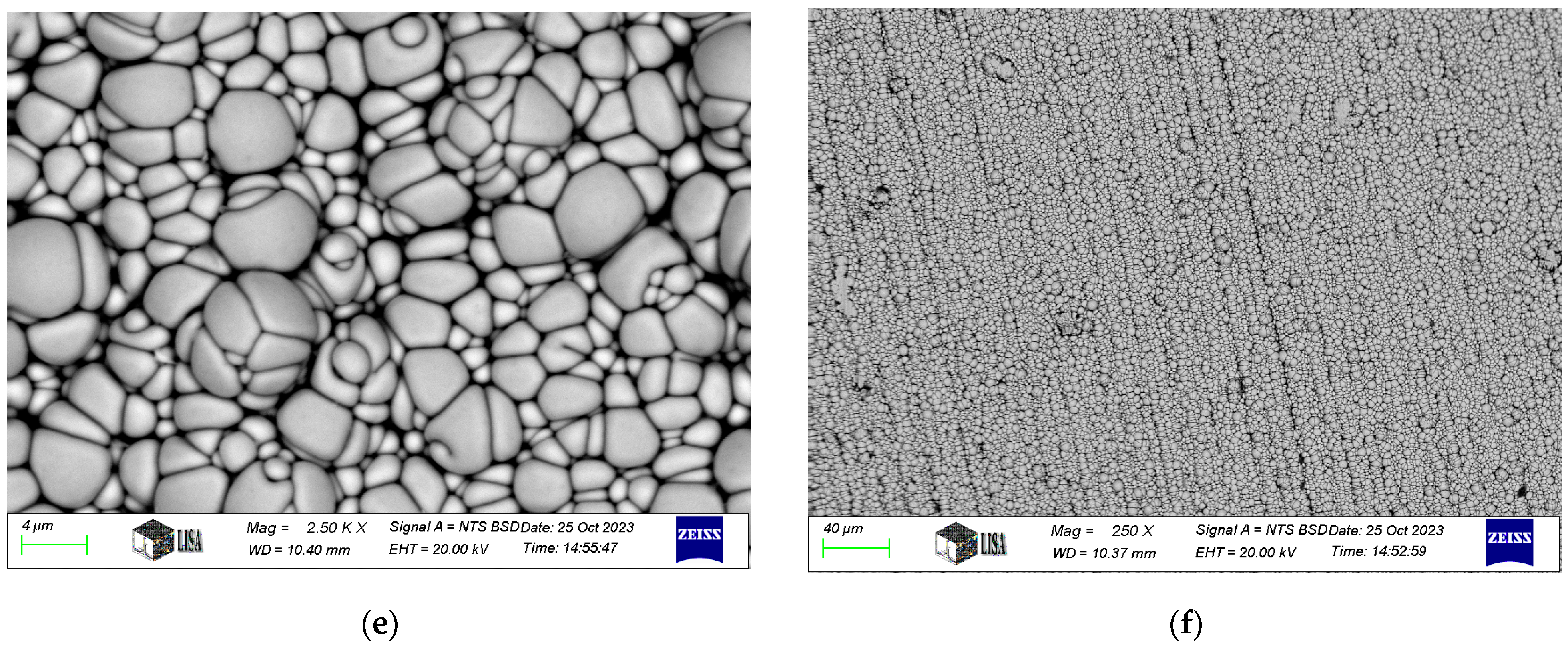

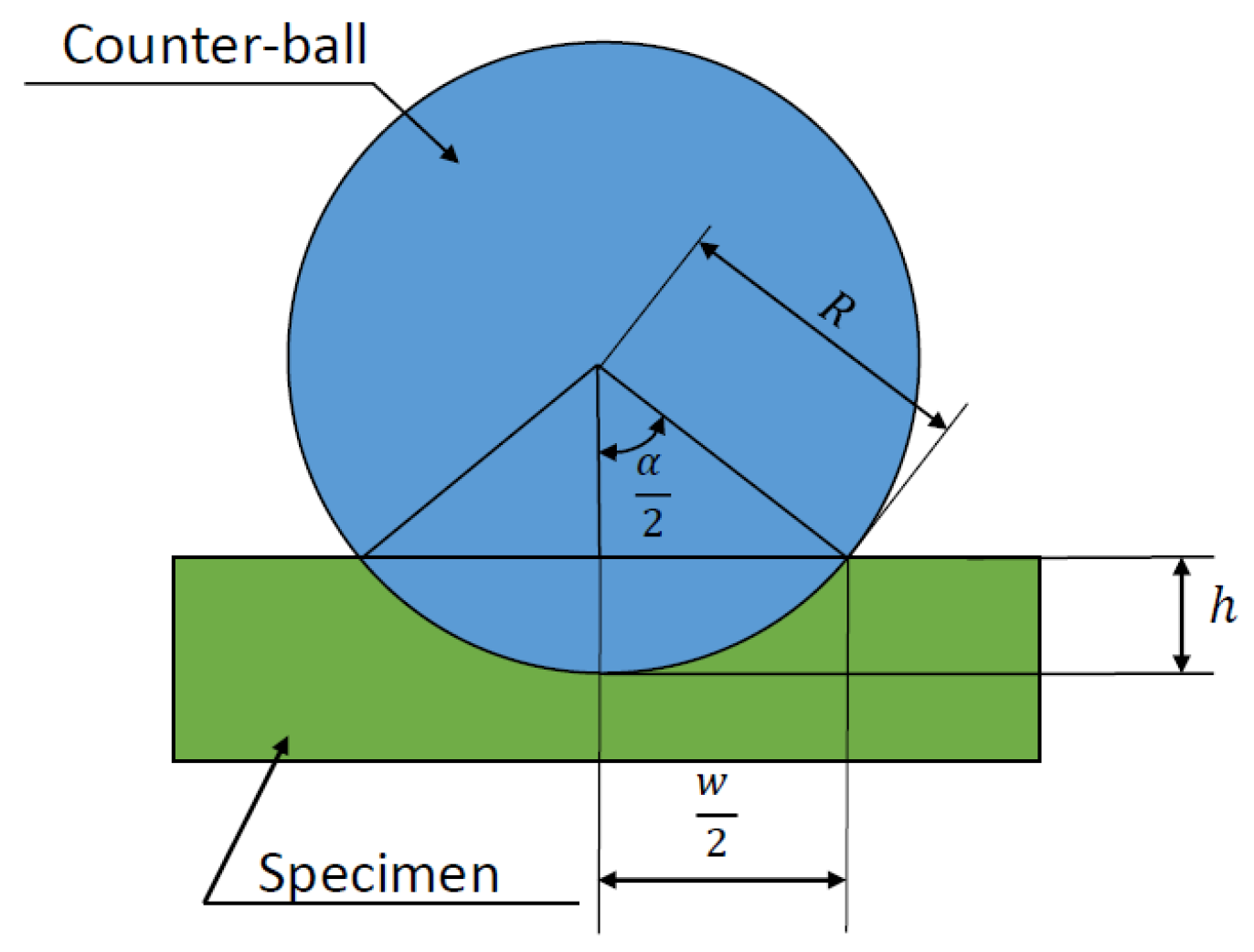
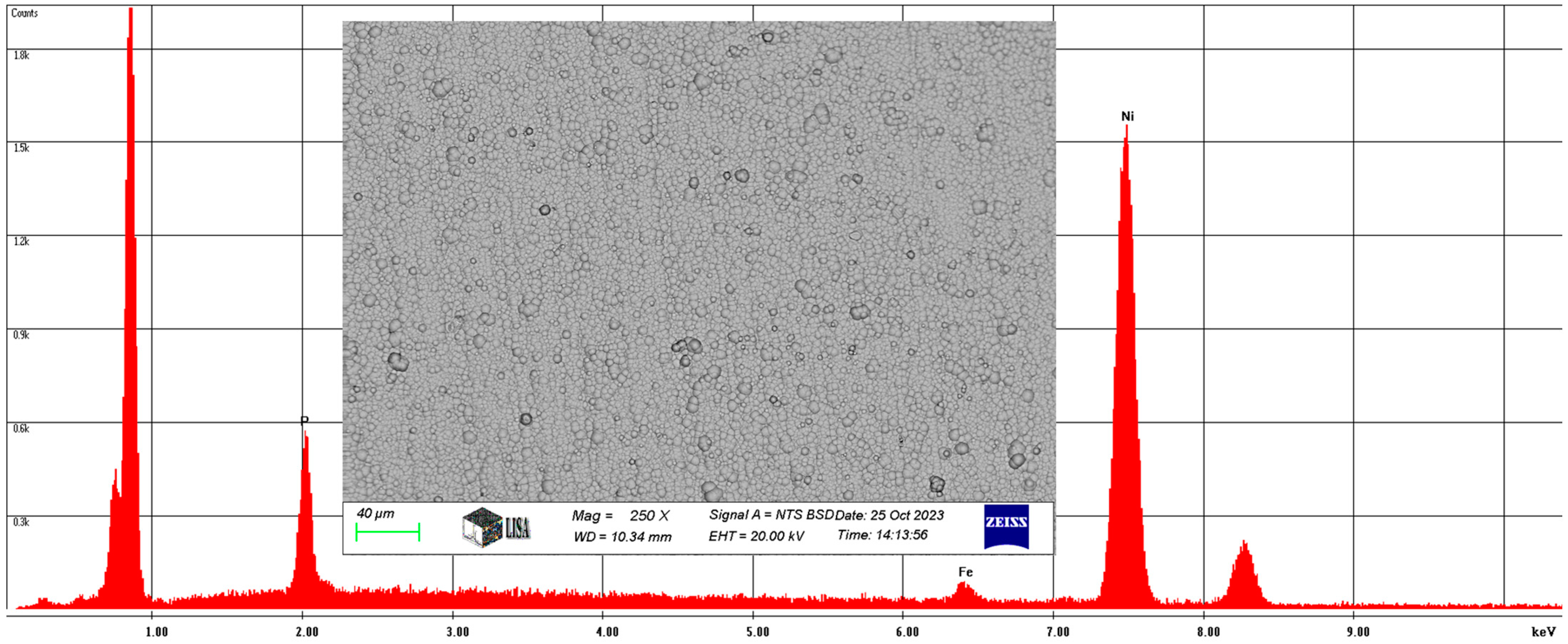
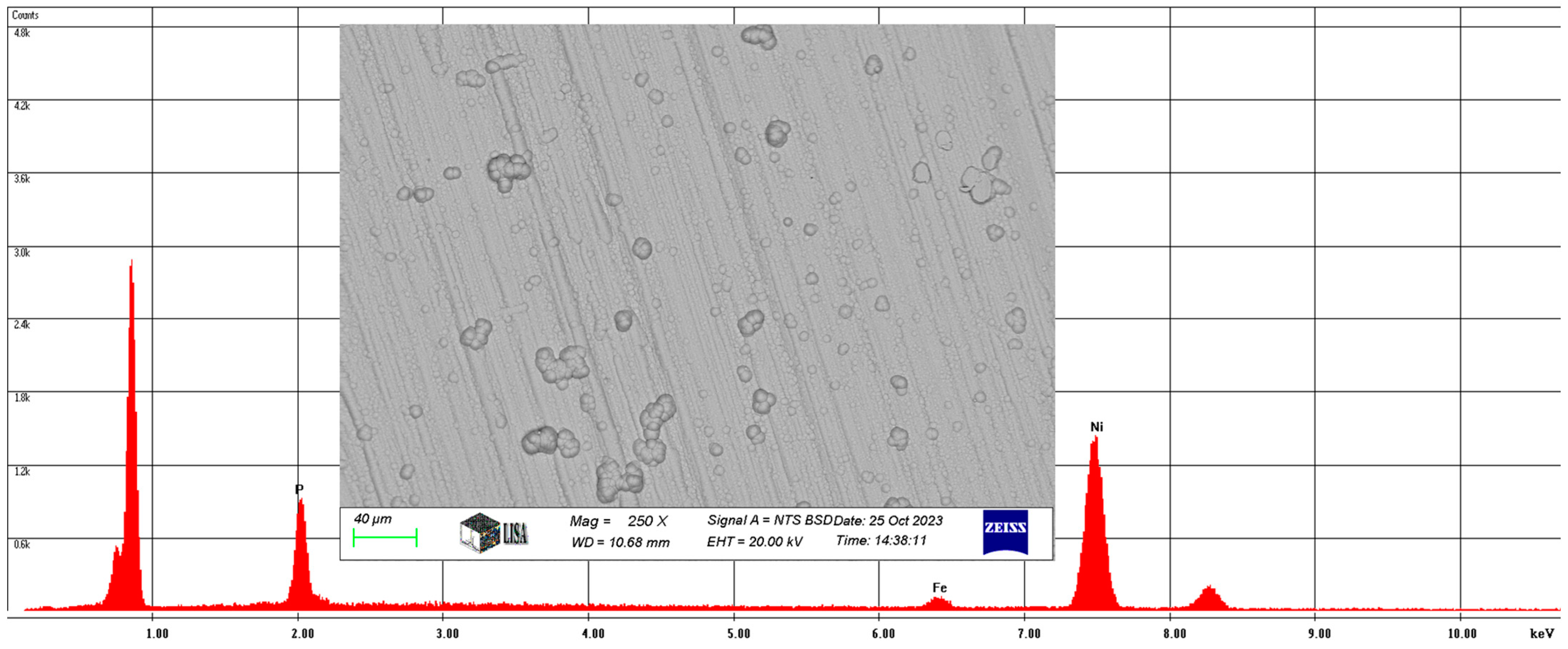

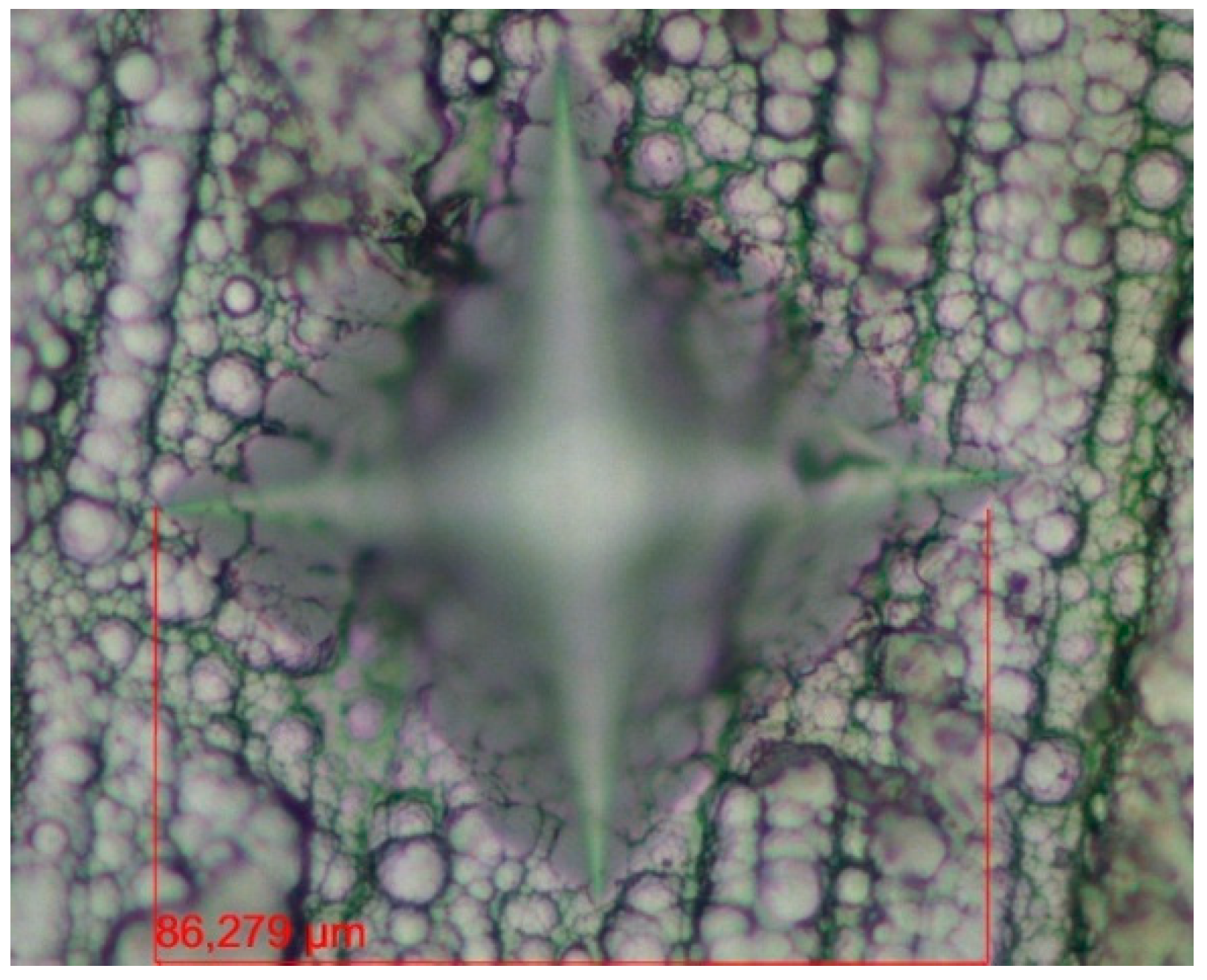

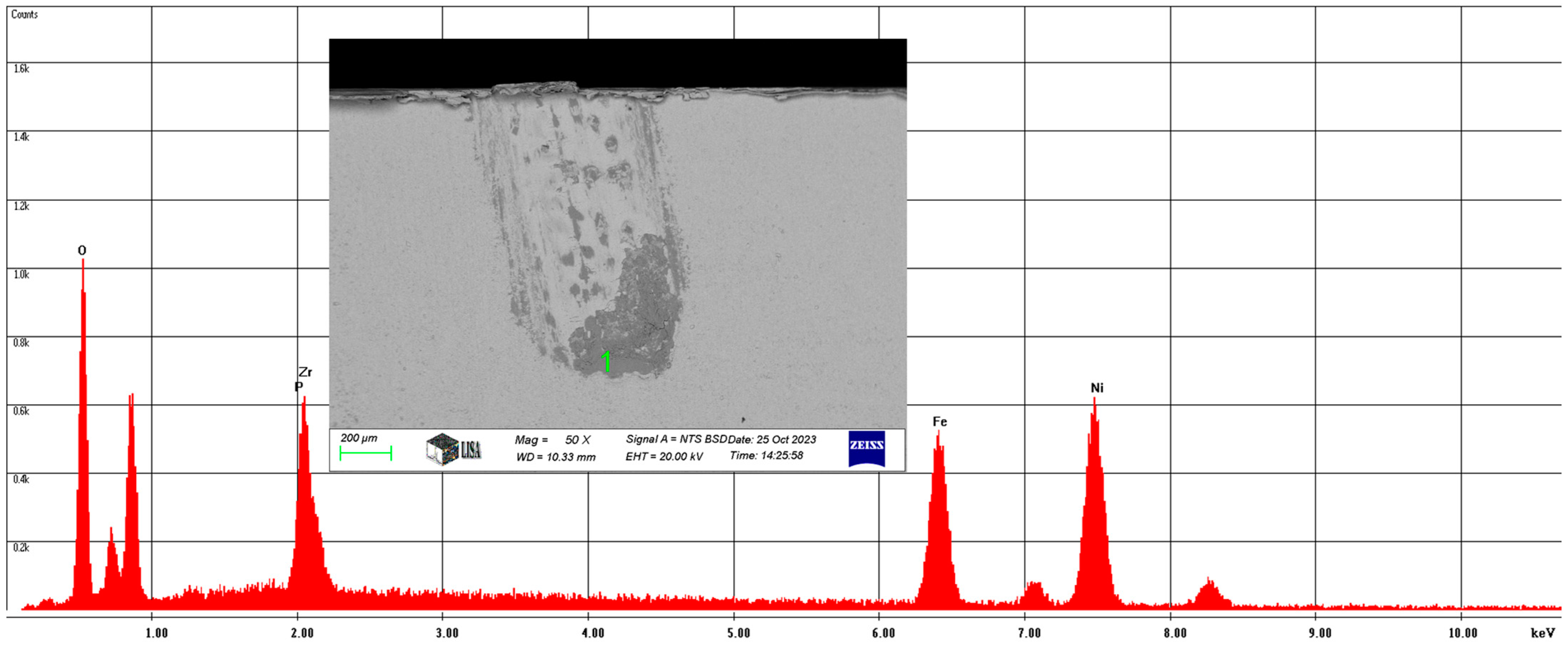
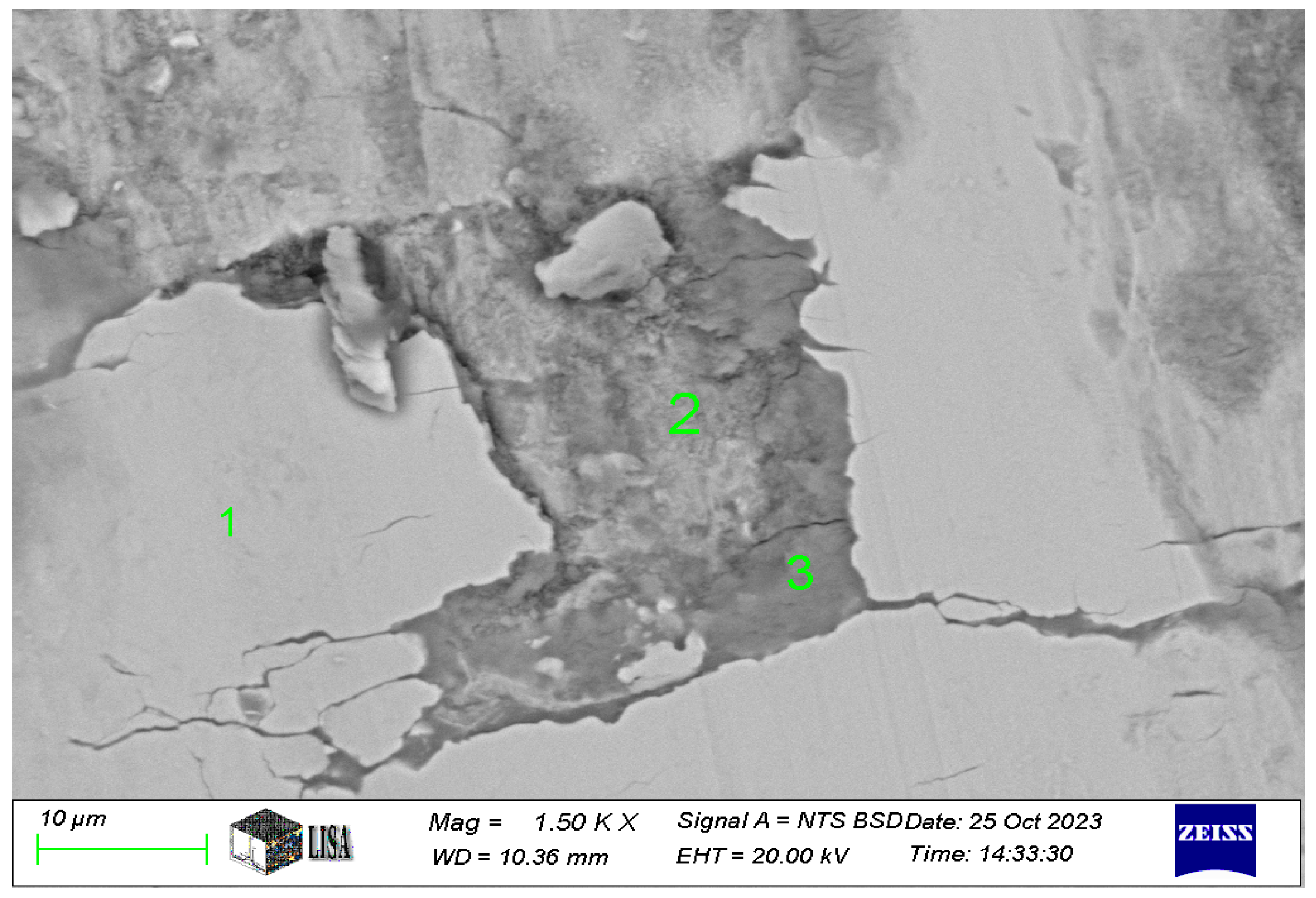

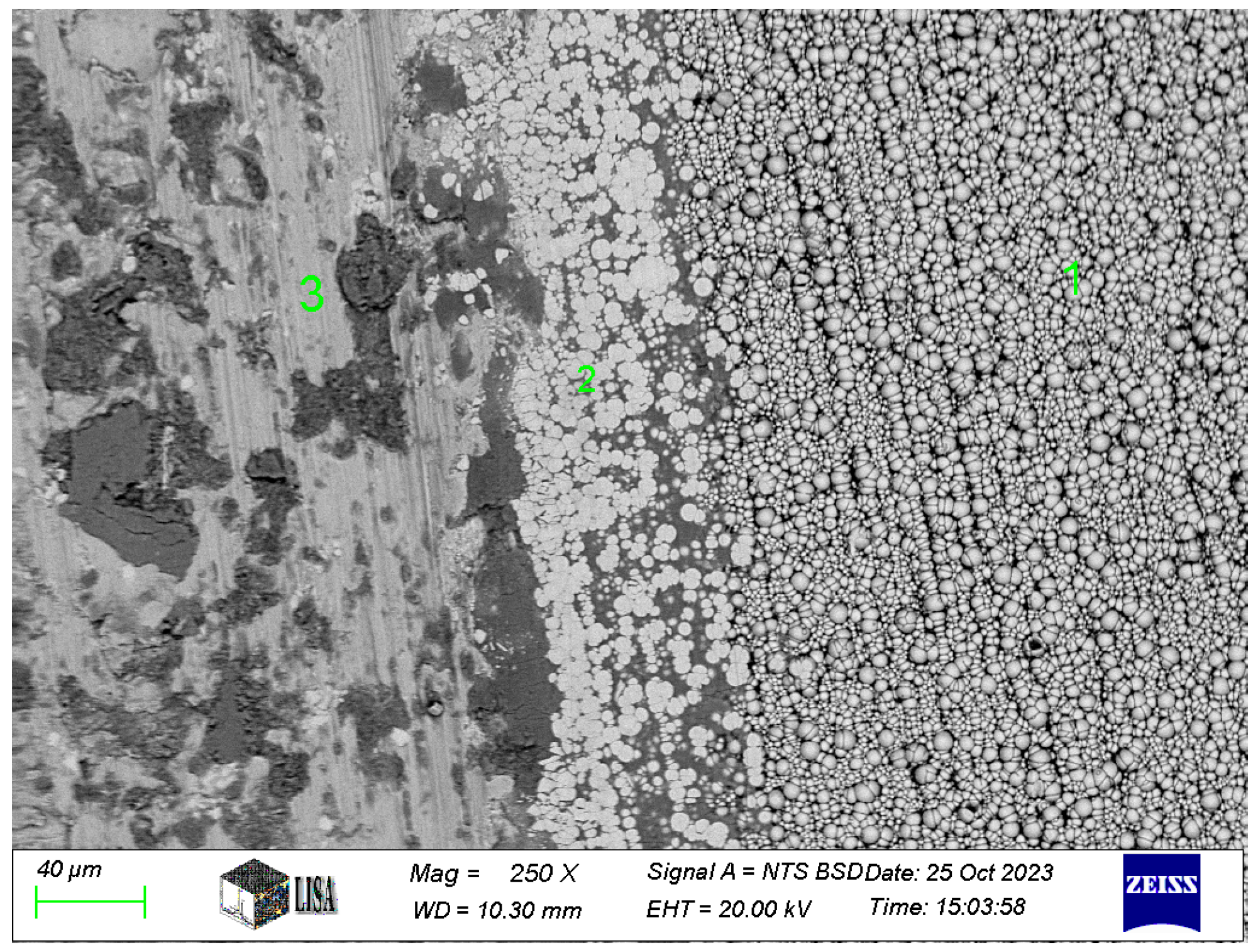




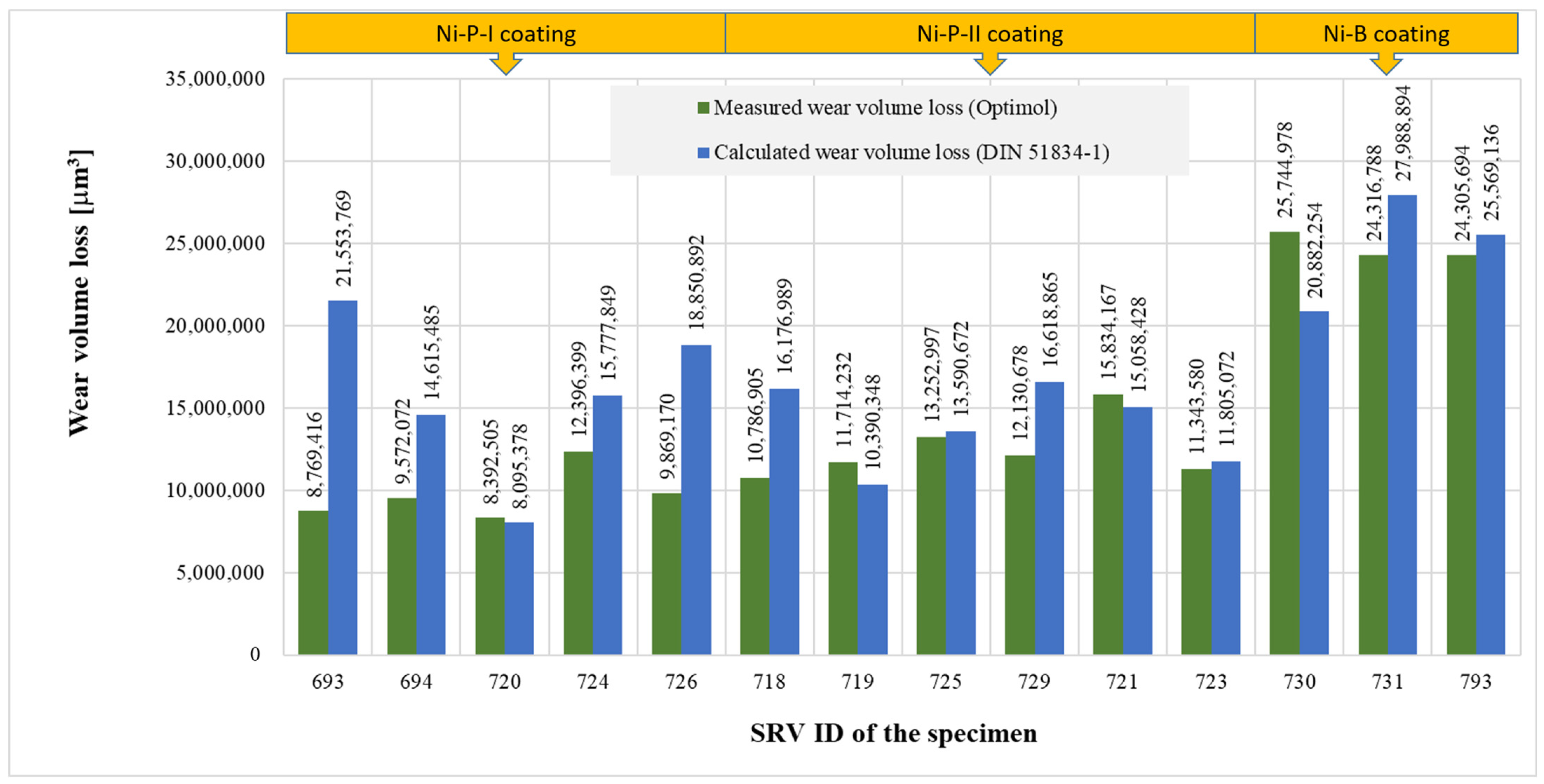
| Bath Composition | Ni-P I | Ni-P II |
|---|---|---|
| (g/L) | 15 | 15 |
| NaH2PO2 (g/L) | 14 | 14 |
| CH3COONa (g/L) | 13 | 13 |
| Thiourea (mg/L) | 1 | 1 |
| H2SO4 | - | adjusted to pH |
| Conditions | ||
| pH | 6 | 4 |
| T (°C) | 80 | 80 |
| Deposition time (min) | 60 | 60 |
| Bath Composition | Ni-B |
|---|---|
| NiCl2 (g/L) | 20 |
| C2H4(NH2)2 (g/L) | 90 |
| NaOH (g/L) | 90 |
| NaBH4 (g/L) | 1.2 |
| Thiourea (mg/L) | 1 |
| Conditions | |
| pH | >13 |
| T (°C) | 85 |
| Deposition time (min) | 60 |
| Coating Type | ||
|---|---|---|
| Ni-P-I | Ni-P-II | Ni-B |
| 7 | 6 | 8 |
| Coating | Ni-P-I | Ni-P-II | Ni-B |
|---|---|---|---|
| Average HV 0.01 | 543 | 499 | 429 |
| Error % | 16.19 | 17.10 | 22.84 |
| Coating | Average of Minimal COF | Average of Maximal COF | Average of Average COF | Error % |
|---|---|---|---|---|
| Ni-P-I | 0.8882 | 1.0908 | 1.0074 | 9.87 |
| Ni-P-II | 0.6871 | 0.9990 | 0.8408 | 5.61 |
| Ni-B | 0.8211 | 1.0330 | 0.8960 | 0.91 |
| Measuring Areas | 1 | 2 | 3 | |||
|---|---|---|---|---|---|---|
| w% | at% | w% | at% | w% | at% | |
| P | 4.22 | 7.69 | 1.31 | 1.94 | 2.24 | 3.02 |
| Fe | 4.66 | 4.71 | 62.13 | 50.97 | 12.67 | 9.50 |
| Ni | 91.12 | 87.60 | 20.17 | 15.74 | 51.80 | 36.96 |
| O | - | - | 9.79 | 28.03 | 16.31 | 42.71 |
| Zr | - | - | 6.60 | 3.32 | 16.99 | 7.81 |
| Measuring Areas | 1 | 2 | ||
|---|---|---|---|---|
| w% | at% | w% | at% | |
| P | 2.78 | 3.32 | 9.66 | 16.82 |
| Fe | 35.01 | 23.20 | 3.89 | 3.76 |
| Ni | 31.81 | 20.06 | 86.45 | 79.42 |
| O | 21.54 | 49.82 | - | - |
| Zr | 8.86 | 3.60 | - | - |
| Measuring Area | 1 | 2 | 3 | |||
|---|---|---|---|---|---|---|
| w% | at% | w% | at% | w% | at% | |
| Fe | 3.09 | 3.24 | 3.50 | 3.67 | 99.59 | 99.61 |
| Ni | 96.91 | 96.76 | 96.5 | 96.33 | 0.41 | 0.39 |
| Coating | w [μm] | l [μm] | WSP [103 μm3] |
|---|---|---|---|
| Ni-P-I | 544 | 5782 | 9800 |
| Ni-P-II | 525 | 5802 | 12,510 |
| Ni-B | 635 | 5855 | 25,031 |
| Coating | |
|---|---|
| Ni-P-I | 5.718 × 10−6 |
| Ni-P-II | 7.009 × 10−6 |
| Ni-B | 1.251 × 10−5 |
| Sample | ||
|---|---|---|
| Ni-P-I-2 | 7072 | 3702 × 10−6 |
| Ni-P-II-1 | 6917 | 3368 × 10−6 |
| Ni-B-3 | 10,121 | 5429 × 10−6 |
Disclaimer/Publisher’s Note: The statements, opinions and data contained in all publications are solely those of the individual author(s) and contributor(s) and not of MDPI and/or the editor(s). MDPI and/or the editor(s) disclaim responsibility for any injury to people or property resulting from any ideas, methods, instructions or products referred to in the content. |
© 2025 by the authors. Licensee MDPI, Basel, Switzerland. This article is an open access article distributed under the terms and conditions of the Creative Commons Attribution (CC BY) license (https://creativecommons.org/licenses/by/4.0/).
Share and Cite
Bányai, K.; Czagány, M.; Kovács, S.; Bognár, G. Characterisation of Tribological Properties and Morphologies of Ni-P and Ni-B Coatings. Lubricants 2025, 13, 168. https://doi.org/10.3390/lubricants13040168
Bányai K, Czagány M, Kovács S, Bognár G. Characterisation of Tribological Properties and Morphologies of Ni-P and Ni-B Coatings. Lubricants. 2025; 13(4):168. https://doi.org/10.3390/lubricants13040168
Chicago/Turabian StyleBányai, Kristóf, Máté Czagány, Sándor Kovács, and Gabriella Bognár. 2025. "Characterisation of Tribological Properties and Morphologies of Ni-P and Ni-B Coatings" Lubricants 13, no. 4: 168. https://doi.org/10.3390/lubricants13040168
APA StyleBányai, K., Czagány, M., Kovács, S., & Bognár, G. (2025). Characterisation of Tribological Properties and Morphologies of Ni-P and Ni-B Coatings. Lubricants, 13(4), 168. https://doi.org/10.3390/lubricants13040168







